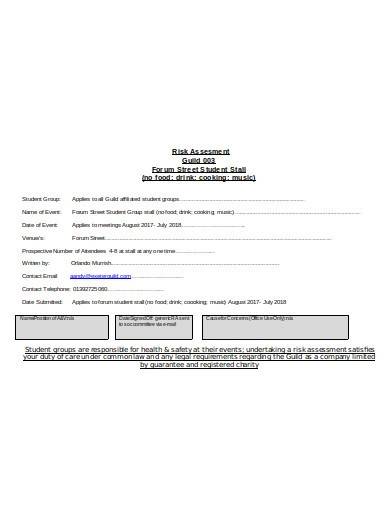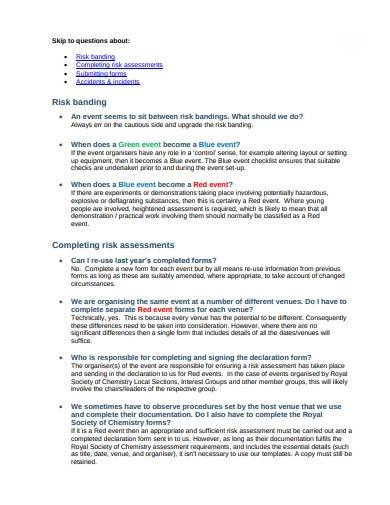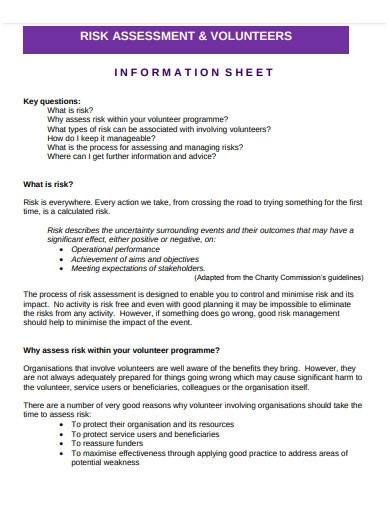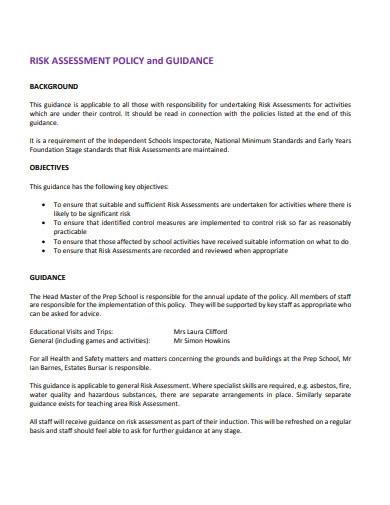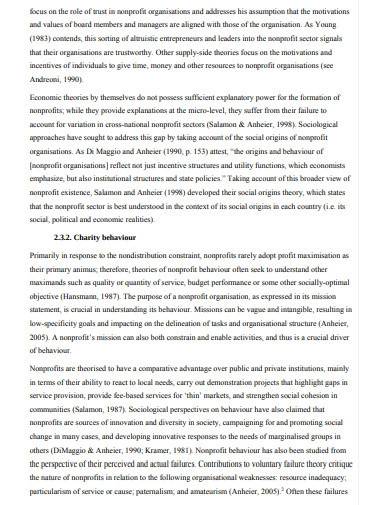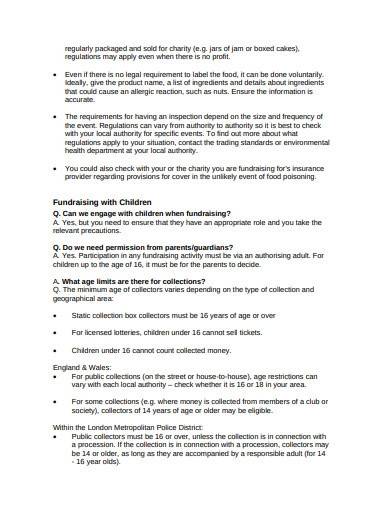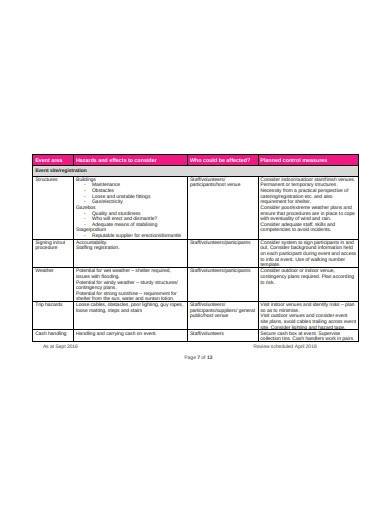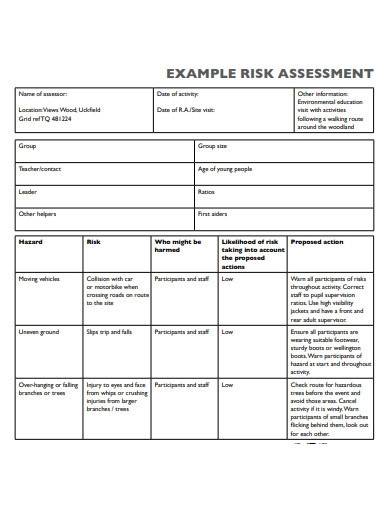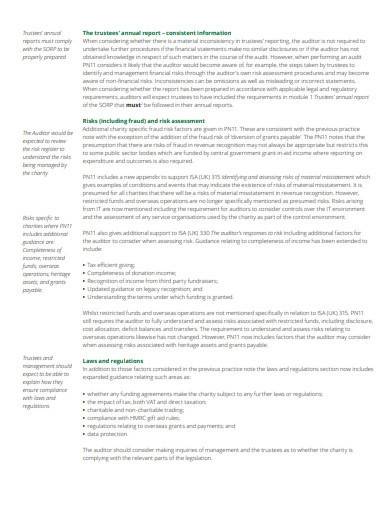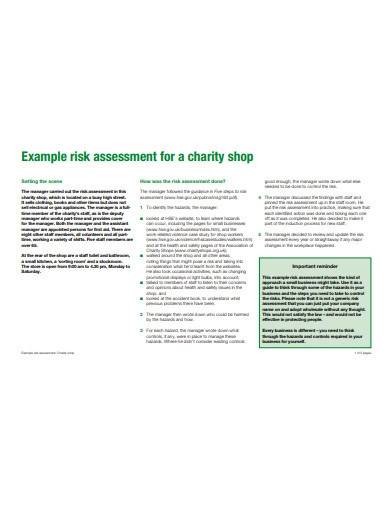Risks can happen anytime and anywhere. It can appear to a business, individual, and organization. That is why it is essential to determine it to generate precautionary measures that will prevent it from happening. If you are part of a charity, it is your duty to equip your organization with effective and efficient risk management strategies. And that is why risk assessment is necessary. In this article, you will be able to learn the importance of risk assessment to nonprofit organizations. Continue reading below.
FREE 10+ Charity Risk Assessment Samples & Templates in PDF | MS Word
This article presents to you charity risk assessment samples and templates that come with professionally written suggestive content that you can use as a reference. These sample templates are also pre-formatted in PDF and MS Word file formats and customizable anytime. Check them out!
1. Charity Risk Assessment Template
2. Charity Risk Self-Assessment Checklist
3. Charity Risk Assessment & Management
4. Charity Risk Assessment & Volunteers Sheet
5. Risk Assessment Policy & Guidance
6. Charity Risk and Resilience Assessment
7. Simple Charity Risk Assessment Template
8. Sample Charity Event Risk Assessment
9. Basic Charity Risk Assessment
10. Standard Charity Risk Assessment
11. Charity Risk Assessment Format Template
What is the Charity Risk Assessment?
According to an article from Chron, risk assessment is important in determining hazards that a business or an organization might face. Hence, it is a necessity. Failure to execute risk assessment, organizations will remain reactive, as stated in an article from Medium. So, if you want to ensure a risk-free environment for your charity and staff, you must not ignore risk assessment.
A charity risk assessment is a process that evaluates risks that may appear in a charity organization and generates precautions that will remove, minimize, or control the hazards from happening. Risks are inevitable. Thus, it is essential for risk assessment to be prioritized by organizations. A risk assessment for charities is important since it plays an integral part in occupational health and safety management plan.
How to Do a Charity Risk Assessment
According to an article from Medium, doing a risk assessment is not easy, and sometimes it becomes the only risk management activity that is left out for some organizations. A risk assessment is useful when comes to making a nonprofit business plan for your charity. That is why it needs to be well-executed. The process might get a little complex, and there are several things that need to be considered to make it accurate. To help you with that, we have provided you some tips that you may follow. Here’s how.
1. Identify Possible Risks
Start your charity risk assessment by doing a risk register, which means identifying the risks that may appear within your organization and listing them down. Do this by evaluating your environment, ask the opinions of your team, etc. Make sure that you will cover all the risks that might harm your charity organization, regardless of its size. Identifying long-term hazards should also be determined.
2. Know the People at Risk
After you have already identified the risks, the next thing you need to do is to know who might be harmed. Doing this will help you determine the right way of handling the hazards. However, knowing the people at risk does not mean listing their names one by one, you may classify them depending on their position in the organization.
3. Come Up with Reasonable Precautions
Having identified the risks that might surface in your charity, you then have to settle what needs to be done and start with establishing reasonable precautions. This area of your charity risk assessment is necessary since this is where you will come up with strategies and action plans that will prevent the risks from happening. Hence, it is imperative to evaluate precautions over and over again until you settle that it will work.
4. Document and Implement Findings
Once you are done with your charity risk assessment, the next thing you need to do is document your findings and implement them in your charity organization. Writing down your charity risk assessment results makes it more professional and accessible. In doing so, make sure to KISS—keep it short and simple.
5. Evaluate and Update
Change is the only constant thing in this world. With that, things are most likely to change from the beginning of your charity risk assessment. Therefore, it is fair to say that evaluating your risk assessment document on an ongoing basis. See to it the changes that need to be done. Nevertheless, your charity risk assessment report must be up to date.
FAQ’s
What are the benefits of risk assessment?
A risk assessment helps an organization minimize risks, complies with safety regulations, and maintains a healthy work environment. However, risk assessment is not only that. It also provides benefits that will better the operations of an organization. These benefits include high productivity and quality of activities, a positive and happier team, less financial spendings, and an impressive public image.
What are the methods of risk assessment?
There are different methods in conducting a risk assessment, and the most commonly used are what-if analysis, fault tree analysis (FTA), failure mode event analysis (FMEA), hazard operability analysis (HAZOP), incident bowtie, and event tree. These methods differ in different organizations and sectors. However, a chosen risk assessment method must suit the process.
What should a risk assessment include?
A risk assessment must include a proper check and evaluation of the environment, the people that might be affected, accurate assessment of risks, reasonable and feasible precautions, and low-rate of risks. These must be presented in your risk assessment statement to be able to come up with competent action plans.
What are the types of risk assessment?
There are risk assessment types that anyone can use to evaluate their organizations. These types consist of qualitative risk assessment, quantitative risk assessment, generic risk assessment, site-specific risk assessment, and dynamic risk assessment. These types are the most commonly used ones in identifying high risks and actions that need to be done to reduce it.
A risk assessment is useful for everyone—business and organization owners, self-employed professionals, and even the ones who are at home. It helps an individual handle risk and prevents it from happening. But, a risk analysis not all that, it also helps businesses and organizations in decision-making. A risk assessment must be properly performed for it to work. Therefore, if you want to make sure that your charity organization will be able to get rid of hazards that may occur every now and then, you will need to do it.
Related Posts
FREE 8+ Non Profit Balance Sheet Templates in MS Word PDF
FREE 9+ Survey Templates in MS Word PDF
FREE 52+ Sample Company Letterhead Templates in Illustrator ...
FREE 12+ Management Job Description Samples in MS Word PDF
FREE 10+ Project Scope Statement Samples in PDF MS Word
FREE 36+ Introduction Speech Samples in PDF
FREE 10+ Responsibility Assignment Matrix Samples in PDF MS ...
FREE 8+ Boston Matrix Samples in PDF MS Word
FREE 45+ Event Proposals in PDF MS Word | Pages | Google Docs
Sample Non Profit Budget Template
Sample Supplier Evaluation
FREE 13+ Non Profit Business Plan Samples in Google Docs MS ...
FREE 59+ Event Proposal Samples in MS Word PDF | Excel ...
FREE 46+ Sample Event Proposal Templates in MS Word
FREE 11+ Profit and Loss Statement Samples and Templates in ...

